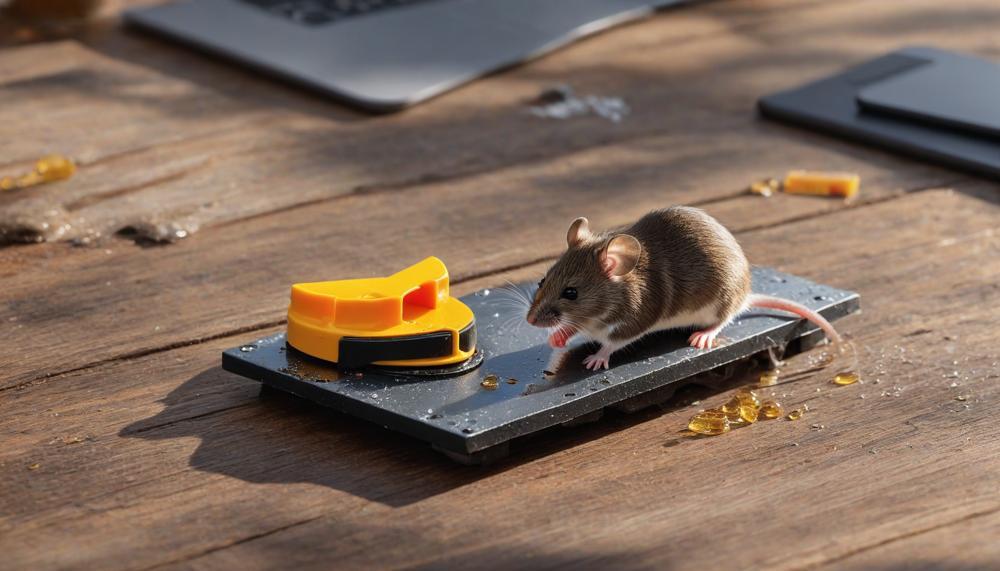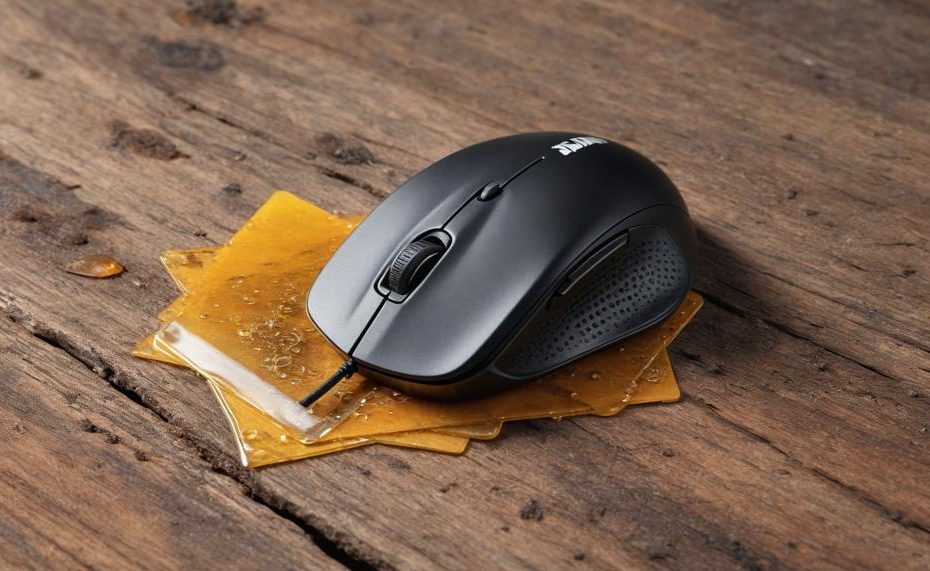No, glue mouse traps are not inherently toxic to humans. However, their strong adhesive can pose certain risks. While the adhesive is not poisonous, it can cause skin irritation, allergic reactions, or respiratory issues if ingested or inhaled.
Accidental contact with the adhesive can lead to discomfort and can be challenging to remove. Proper handling and disposal are essential to minimize these risks.
Key Takeaways:
- Non-toxic but Irritating: Glue traps are not toxic but can cause skin irritation and allergic reactions.
- Respiratory Concerns: Inhaling fumes from the adhesive might lead to respiratory problems.
- Accidental Ingestion: Ingesting the adhesive can result in stomach issues and may require medical attention.
- Handling Tips: Always use gloves when handling glue traps and keep them away from children and pets.
- Humane Alternatives: Consider other methods for catching mice that are safer and more humane.
Whether you’re dealing with a mouse problem at home or just curious about the safety of these common traps, understanding their potential risks is crucial for safe and effective pest control.
Table of Contents
Glue Traps Cause Prolonged Suffering
Glue mouse traps cause prolonged suffering for trapped animals through a variety of distressing and often fatal mechanisms. Below is a detailed breakdown of the ways in which these traps inflict suffering on the animals they capture:

| Mechanism | Details | Implications |
| Starvation and Dehydration | Trapped animals are unable to access food or water. | This leads to slow death from hunger and thirst, causing immense stress and pain. |
| Suffocation | Animals can become stuck face-down in the glue, blocking their airways. | Leads to a slow, painful death by suffocation. |
| Self-inflicted Injuries | Animals often attempt to free themselves, resulting in torn skin, broken limbs, or other injuries. | These injuries cause severe pain and can lead to infections and further suffering. |
| Predation | Trapped animals are vulnerable to predators. | Predators can cause additional injuries or a terrifying death for the trapped animal. |
| Exposure | Animals may be left exposed to harsh environmental conditions. | This can result in hypothermia, hyperthermia, or death from prolonged exposure. |
| Psychological Stress | Being stuck and unable to escape causes extreme fear and anxiety. | This psychological stress adds to the overall suffering of the animal. |
Additional Insights
- Self-Mutilation: Animals frequently chew off their own limbs in desperate attempts to escape, exacerbating their pain and suffering.
- Long Duration: It can take hours or even days for animals to die in glue traps, leading to prolonged agony.
- Non-Target Species: Glue traps often ensnare unintended animals like birds, reptiles, and small mammals, causing widespread suffering beyond the intended rodent targets.
The use of glue traps is widely regarded as inhumane. They inflict unnecessary suffering and are not an effective method for controlling rodent populations.
Glue Traps Are Completely Indiscriminate
Glue traps work by utilising a tray or board coated with a highly adhesive substance. When an animal steps onto the trap, it becomes ensnared by the sticky surface, unable to free itself. This method is favoured for its simplicity and effectiveness in immobilising rodents and other pests without the use of toxins.
However, glue traps are considered indiscriminate due to their lack of specificity in targeting only pests. These traps can ensnare any animal that comes into contact with them, including non-target species such as birds, bats, hedgehogs, and even domestic pets like cats and dogs.
This poses significant ethical and ecological concerns, as these unintended captures often lead to prolonged suffering and death for the trapped animals.
Key Points on Glue Traps
| Aspect | Details |
| Function | Glue traps use a sticky adhesive surface to immobilize animals that come into contact with them. |
| Target Species | Primarily designed for rodents such as mice and rats. |
| Non-target Species | Wild birds, bats, hedgehogs, fox cubs, and domestic pets. |
| Ethical Concerns | Causes prolonged suffering, starvation, suffocation, and psychological stress. Considered inhumane by many animal welfare organisations. |
| Legislation | Some regions, like Scotland, have recognised the risks and are considering or have implemented restrictions on their use. |
Glue Traps Are a Health Hazard
Glue mouse traps pose a health hazard to humans primarily due to the potent adhesive they contain. This adhesive can cause a variety of health issues if it comes into contact with the skin, is inhaled, or ingested. Below is an analysis of how these traps can be harmful to humans:
| Health Risk | Description | Prevention |
| Skin Irritation | Contact with the adhesive can cause skin irritation and dermatitis, leading to redness, itching, and swelling. | Wear gloves when handling traps and wash hands thoroughly after use. |
| Allergic Reactions | Prolonged or repeated exposure to the adhesive may trigger allergic reactions in sensitive individuals, resulting in hives, rashes, or severe dermatitis. | Avoid direct contact with the adhesive and use alternative traps if you have a known allergy. |
| Respiratory Issues | Inhalation of fumes from the adhesive can irritate the respiratory tract, causing coughing, sneezing, or difficulty breathing. | Use traps in well-ventilated areas and avoid inhaling near the traps. |
| Gastrointestinal Problems | Accidental ingestion of the adhesive can lead to nausea, vomiting, and abdominal pain. In severe cases, it may require immediate medical attention. | Keep traps out of reach of children and pets, and seek medical help if ingestion occurs. |
Given these potential health hazards, it’s essential to handle glue traps with caution. Here are some safety tips and alternative solutions:
- Handle with Care: Always wear protective gloves when setting or disposing of glue traps to prevent skin contact.
- Proper Disposal: Dispose of used traps in sealed bags to avoid accidental exposure and to prevent pets or children from accessing them.
- Alternatives: Consider using other pest control methods such as electronic traps, snap traps, live catch traps, or natural deterrents, which can be safer for humans and more humane for non-target species.
By following these precautions and considering alternative pest control methods, you can mitigate the health risks associated with glue mouse traps.
Glue Traps Don’t Work
Glue traps don’t work effectively when compared to other types of mouse traps in terms of both effectiveness and human safety.
In terms of effectiveness, glue traps depend heavily on factors like baiting, placement, and the presence of other food sources. While they can be effective for small infestations, they struggle with larger infestations. This inconsistency makes them a less reliable option compared to other traps.
Effectiveness Comparison:
| Type of Trap | Effectiveness | Notes |
| Glue Traps | Variable | Effective for small infestations; highly dependent on placement and bait. |
| Snap Traps | High | Quick and reliable; kills mice instantly. |
| Live Traps | Moderate | Effective if checked regularly; allows for humane release. |
| Electronic Traps | High | Efficient and quick; kills mice instantly with an electric shock. |
Human Safety Comparison:
Glue traps pose significant safety risks. The adhesive can cause skin irritation, allergic reactions, and respiratory issues.
Additionally, trapped mice may carry diseases that can be transmitted to humans through contact with the trap. These health risks are not present or are significantly reduced in other types of traps.
Safety Comparison:
| Type of Trap | Human Safety | Notes |
| Glue Traps | Low | Potential for skin irritation, allergies, respiratory issues, and disease transmission. |
| Snap Traps | Moderate | Minimal direct contact; caution needed to avoid accidental triggering. |
| Live Traps | High | Safe with minimal handling; requires regular checking to prevent mouse stress. |
| Electronic Traps | High | Minimal handling; safe if used correctly and regularly maintained. |
Overall, while glue traps may offer some initial advantages like low cost and ease of use, their drawbacks in effectiveness and human safety make other types of mouse traps a better choice for both humane pest control and reducing health risks. For more humane and effective options, consider snap traps or live traps, which can provide more consistent results and pose fewer safety concerns.
Always Be Kind to Rodents
To safely and humanely remove rodents from your home without using toxic glue traps, consider these alternatives:
| Method | Description | Benefits |
| Snap Traps | Quickly kill rodents with a spring-loaded bar | Effective, immediate results |
| Live Traps | Capture rodents alive for release | Humane, non-lethal |
| Electronic Traps | Deliver an electric shock to kill rodents | Clean, quick, humane |
| Natural Deterrents | Use scents or sounds to repel rodents | Safe, chemical-free |
| Rodent-Proofing | Seal entry points to prevent entry | Long-term prevention |
| Proper Sanitation | Keep your home clean and food secure | Reduces attraction to rodents |
Did You Find an Animal on a Glue Trap?
The short answer is to act swiftly and carefully to free the animal with minimal harm. Follow these detailed steps:
| Step | Action | Details |
| 1 | Protect Yourself and the Animal | Wear gloves to prevent stress and injury. |
| 2 | Prepare to Remove the Animal | Gather vegetable oil, tissue, and a container. |
| 3 | Apply Oil Sparingly | Use a few drops of oil around stuck areas. |
| 4 | Work Slowly and Gently | Free the animal slowly to avoid harm. |
| 5 | Cover the Trap | Place tissue over glue to prevent re-sticking. |
| 6 | Immediate Care Post-Removal | Check for lethargy or injury and seek help if needed. |
| 7 | Seek Professional Advice | Contact PETA at 757-622-7382 for guidance. |
| 8 | Report Unlawful Traps | Inform local animal control or wildlife officials. |
Conclusion
Glue mouse traps are not toxic to humans, but they come with several risks that should not be ignored. The adhesive used in these traps, while non-poisonous, can cause skin irritation, allergic reactions, and even respiratory issues if inhaled. Accidental contact with the adhesive is uncomfortable and difficult to manage, necessitating careful handling and disposal. Wearing gloves and ensuring these traps are out of reach of children and pets can mitigate some of these hazards.
Despite their non-toxicity, the ethical concerns surrounding glue traps are significant. These traps cause prolonged suffering for trapped animals through starvation, dehydration, suffocation, self-inflicted injuries, predation, and exposure to harsh conditions. The psychological stress endured by animals unable to escape further compounds their distress. Additionally, glue traps are indiscriminate, often capturing non-target species like birds, reptiles, and domestic pets, leading to widespread, unintended suffering.
For those dealing with rodent issues, it’s advisable to consider more humane alternatives such as snap traps, electronic traps, or live traps. These methods not only reduce animal suffering but also provide a safer, more ethical approach to pest control.






